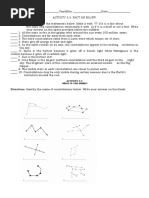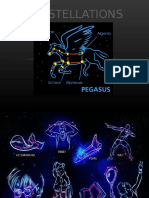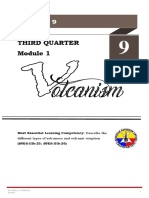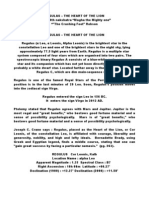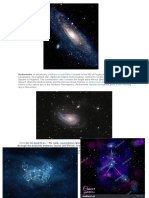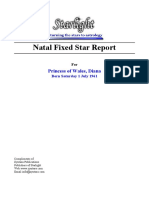0 ratings0% found this document useful (0 votes)
1K viewsConstellation
Constellation
Uploaded by
Anonymous xMXvFtThe document discusses several winter constellations visible in the northern hemisphere including Orion, the hunter, which contains the bright stars Betelgeuse and Rigel forming a rectangle shape, and its sword containing the Orion Nebula. Auriga, the charioteer, contains the bright yellow star Capella and has an uncertain origin story that involves either Neptune or a legendary king of Athens.
Copyright:
© All Rights Reserved
Available Formats
Download as PPT, PDF, TXT or read online from Scribd
Constellation
Constellation
Uploaded by
Anonymous xMXvFt0 ratings0% found this document useful (0 votes)
1K views7 pagesThe document discusses several winter constellations visible in the northern hemisphere including Orion, the hunter, which contains the bright stars Betelgeuse and Rigel forming a rectangle shape, and its sword containing the Orion Nebula. Auriga, the charioteer, contains the bright yellow star Capella and has an uncertain origin story that involves either Neptune or a legendary king of Athens.
Original Title
Constellation.ppt
Copyright
© © All Rights Reserved
Available Formats
PPT, PDF, TXT or read online from Scribd
Share this document
Did you find this document useful?
Is this content inappropriate?
The document discusses several winter constellations visible in the northern hemisphere including Orion, the hunter, which contains the bright stars Betelgeuse and Rigel forming a rectangle shape, and its sword containing the Orion Nebula. Auriga, the charioteer, contains the bright yellow star Capella and has an uncertain origin story that involves either Neptune or a legendary king of Athens.
Copyright:
© All Rights Reserved
Available Formats
Download as PPT, PDF, TXT or read online from Scribd
Download as ppt, pdf, or txt
0 ratings0% found this document useful (0 votes)
1K views7 pagesConstellation
Constellation
Uploaded by
Anonymous xMXvFtThe document discusses several winter constellations visible in the northern hemisphere including Orion, the hunter, which contains the bright stars Betelgeuse and Rigel forming a rectangle shape, and its sword containing the Orion Nebula. Auriga, the charioteer, contains the bright yellow star Capella and has an uncertain origin story that involves either Neptune or a legendary king of Athens.
Copyright:
© All Rights Reserved
Available Formats
Download as PPT, PDF, TXT or read online from Scribd
Download as ppt, pdf, or txt
You are on page 1of 7
Constellation
What are constellations ?
1. We can see millions of stars in the sky at night .
2. A group of stars can form a pattern .
3. The pattern formed by a group of stars is called a
constellation .
4. Examples of constellations are
* Big Dipper
* Southern Cross
* Orion
* Scorpion
5.
The following
table shows The
information
the
Constella
Pattern
times about
The
constellations
.
tion
when these direction
constellatio
n
shown the
constellati
ons
Big Dipper
A bowl with a
handle
April to June,
North Pole
around 8 p.m.
to 10 p.m.
Southern
Cross
A cross
April to June,
South Pole
around 8 p.m.
to 10 p.m.
Orion
A hunter with
a belt and a
sword
December to
February
Scorpion
North Pole
A scorpion
June to
~
withare
a head,
6. The following
the uses August,
of constellation :
long body, tail around 8 p.m.
(a) To show direction
stingof the time
to 10for
p.m.
(b) To remindand
farmers
harvesting and plantin
Constellation during Spring
Leo, the Lion
The zodiacal constellation Leo, the lion, is one of a
handful of constellations that really does look like its
namesake. Look for Leo high in south in April and May.
Leo's brightest star is blue-white Regulus, one of the
brightest stars in the night sky. Regulus rises almost due
east, with the body of the lion following it into the sky
over the next couple of hours. Once Regulus climbs into
the sky, look to its left toward the north for a group
of stars forming a backward question mark. These stars
outline Leo's head and mane.
About two hours later, look low in the east for Leo's tail
a white star named Denebola an Arabic name that,
appropriately enough, means "tail of the lion."
Cygnus, the Swan
The brightest stars of Cygnus form a cross, so the swan is
also known as the Northern Cross. Find it soaring high
overhead during late summer evenings.
The constellation's brightest star is Deneb an Arabic
word that means "the tail." Deneb the tail of the swan
marks the top of the cross. The swan's outstretched
wings form the horizontal bar of the cross, while the head
of the swan a double star called Albireo is the
bottom of the cross.
Although it lies about 1,500 light-years from Earth, Deneb
shines brightly in our night sky because it's a white
supergiant a star that's much larger, hotter, and
brighter than the Sun. Deneb is the northeastern point of
a star pattern called the Summer Triangle.
If you use binoculars to scan the area between the two
bright stars that define the swan's eastern wing, you'll
see the remnant of a supernova a faint, incomplete
ring of light called the Cygnus Loop.
Constellation during Autumn
Pegasus, the Flying Horse
Pegasus is a large pattern of stars marked by a great
square four bright stars that form the body of the
winged horse.
The brightest star in the Great Square Alpheratz
isn't in the constellation Pegasus. It's in Andromeda,
which is just northeast of Pegasus. It's part of the ancient
sky picture that we know as Pegasus. But when
astronomers drew the official boundaries for the
constellations, this star was placed just across the line in
Andromeda.
The brightest star in the constellation Pegasus is called
Markab, which means "the saddle." It's at the
southwestern corner of the Great Square.
Perseus, the Hero
Perseus, the hero, arcs high overhead in fall and early
winter. Many of its stars are immersed in the faint glow of
our galaxy, the Milky Way. In fact, if you look at Perseus
under dark skies, you may be able to see three of the
spiral
that enfold
the
Milky
Way.
One ofarms
the brightest
and
most
interesting
stars in Perseus
is Algol. The name Algol means "demon star." Ancient
skywatchers thought it was cursed because its brightness
changes. That's because Algol which is about 75 lightyears from Earth is the most famous "eclipsing binary"
star. Today, astronomers know that Algol is two separate
stars. About once every three days, the fainter member
of the pair passes in front of the brighter one, and Algol
grows fainter.
A faint star cluster in Perseus, called M34 is visible with
Constellation during Winter
Orion, the Hunter
Orion is one of the most beautiful of all constellations,
and one of the easiest to find. It looks like a large
rectangle high in winter's south-southeastern sky.
Two of the brightest stars in the evening sky lie at
opposite corners of the rectangle: bright red Betelgeuse
at the northeastern corner and even brighter Rigel at the
southwest. Near the center of the rectangle, look for a
short diagonal line of three stars Orion's belt. And
extending south from the belt, you'll see another, fainter
line of stars that forms Orion's sword.
One of the objects in Orion's sword isn't a star at all. It's a
nebula a cloud of gas and dust that's like a giant
fluorescent bulb. Hot young stars inside the nebula pump
energy into its gas, causing the gas to glow.
Auriga, the Charioteer
Auriga, the celestial charioteer, has neither chariot nor
horse. Instead, he's drawn as a man holding the reins in
his right hand, with a goat on his left shoulder the star
Capella and two baby goats in his left arm. Look for
him cruising high across the southern sky in January and
The constellation has an uncertain origin. It might
February.
represent Neptune rising from the sea in a chariot. Or it
might honor a legendary king of Athens; according to this
tale, he invented a chariot that was drawn by four horses.
Capella is one of the few bright stars that is yellow, like
our Sun. Both Capella and the Sun are yellow because
they have roughly the same surface temperature.
But the light from Capella actually comes from two
separate stars. Both are yellow, and both lie about 43
light-years from Earth. Each star emits dozens of times
more light than the Sun. In fact, any residents of the
Capella system probably would take little notice of our
You might also like
- New Discoveries On The TilmaDocument10 pagesNew Discoveries On The TilmaJaime Adolfo Flores GuerreroNo ratings yet
- 250+ CatalogDocument29 pages250+ CatalogDawn YoungNo ratings yet
- Activity Sheet StarsDocument13 pagesActivity Sheet StarsShielo Marie CabañeroNo ratings yet
- ConstellationsDocument50 pagesConstellationsLawrence MatunogNo ratings yet
- Constellation Making RubricDocument4 pagesConstellation Making RubricXynaNo ratings yet
- CONSTELLATIONSDocument38 pagesCONSTELLATIONSNoemi Gigante100% (2)
- Summative Test in Science 6Document1 pageSummative Test in Science 6Nickmor Oamlin100% (1)
- Constellation Grade 9 IMDocument24 pagesConstellation Grade 9 IMCeleste BawagNo ratings yet
- Science 9Document17 pagesScience 9Kebu Yen100% (4)
- Science 9: Unit 3 Module 3: Stars and ConstellationsDocument35 pagesScience 9: Unit 3 Module 3: Stars and ConstellationsRudyard Pague100% (1)
- Activity No. 6 When The Suns Rays StrikeDocument1 pageActivity No. 6 When The Suns Rays StrikeHarparp Lee100% (4)
- ConstellationsDocument44 pagesConstellationsKatelyn Valera100% (3)
- LeaP Science G9 Week 1 Q3Document4 pagesLeaP Science G9 Week 1 Q3Christine Marquez RamosNo ratings yet
- Learning Activity Sheet: Gershon E. CabangalDocument16 pagesLearning Activity Sheet: Gershon E. CabangalMellegrace EspirituNo ratings yet
- Characteristics of StarsDocument11 pagesCharacteristics of StarsFlorenz Espinosa0% (1)
- Activity ConstellationDocument2 pagesActivity ConstellationMarie VicNo ratings yet
- CONSTELLATIONDocument35 pagesCONSTELLATIONanalyn itaasNo ratings yet
- Science 9 Q3 Week 8.2Document10 pagesScience 9 Q3 Week 8.2Alfred Villego Santiago100% (2)
- Science 6 Week 2Document17 pagesScience 6 Week 2Carmilleah FreyjahNo ratings yet
- Lecture Notes and DiagramDocument2 pagesLecture Notes and Diagramapi-298474962No ratings yet
- Quarter 3 Module 6 Stars and ConstellationsDocument82 pagesQuarter 3 Module 6 Stars and ConstellationsAkisha Jen Calicdan50% (2)
- Science 9 Quarter 3 Module 7 Week 7: ConstellationsDocument4 pagesScience 9 Quarter 3 Module 7 Week 7: ConstellationsYuichi Aizawa100% (2)
- ConstellationsDocument85 pagesConstellationsArvie Jay CastilloNo ratings yet
- G9 Las4 Final-MuntinlupaDocument2 pagesG9 Las4 Final-MuntinlupaRaymond Tindugan100% (1)
- Science: Quarter 3 - Module 6 ConstellationsDocument24 pagesScience: Quarter 3 - Module 6 ConstellationsLourdesCorpusMendoza100% (4)
- Costellation ActivityDocument4 pagesCostellation ActivityFranz Dominic Laus100% (1)
- Learner's Activity Sheet: Science (Quarter III - Week 7)Document6 pagesLearner's Activity Sheet: Science (Quarter III - Week 7)Amimah GuroNo ratings yet
- Grade 9 Lesson Plan ConstellationDocument3 pagesGrade 9 Lesson Plan ConstellationPaulo Alegria100% (1)
- Unit 3 Module 1 Volcano Hand-OutDocument2 pagesUnit 3 Module 1 Volcano Hand-OutJosaiah De Guzman79% (14)
- LAS Science 9 MELC 2 Q2 Week2Document5 pagesLAS Science 9 MELC 2 Q2 Week2Ralph Justine Bolido80% (5)
- Characteristics of StarsDocument17 pagesCharacteristics of StarsMarivynne Lacida100% (1)
- Sci 9 q3 Wlas Week 9Document12 pagesSci 9 q3 Wlas Week 9hazelavenderNo ratings yet
- Science 9 4th Performance Task Q3Document2 pagesScience 9 4th Performance Task Q3Cristina Dapetillo - AmistosoNo ratings yet
- Grade 9 Science Earth 2 DLPDocument12 pagesGrade 9 Science Earth 2 DLPManongdo AllanNo ratings yet
- Grade 9 Constellation LeapDocument4 pagesGrade 9 Constellation LeapCristian PortugalNo ratings yet
- Star Quiz-KEYDocument4 pagesStar Quiz-KEYLouis Fetilo Fabunan100% (1)
- Character Integrated Lesson Plan Science 9Document3 pagesCharacter Integrated Lesson Plan Science 9Cristina AguinaldoNo ratings yet
- Science 9 Worksheet Week 5Document4 pagesScience 9 Worksheet Week 5Jaybie Tejada100% (1)
- ConstellationDocument62 pagesConstellationLudy Lyn100% (1)
- ConstellationsDocument37 pagesConstellationsHans De Los ReyesNo ratings yet
- Science Lesson PlanDocument4 pagesScience Lesson PlanElyn LoRiNo ratings yet
- Science5 Q4 Mod5 TheStarsandConstellations v2Document28 pagesScience5 Q4 Mod5 TheStarsandConstellations v2Pablo Jr. bongdol100% (1)
- Unit 3 Module 1 Volcano Summative TestDocument3 pagesUnit 3 Module 1 Volcano Summative TestJonathan TabbunNo ratings yet
- ConstellationDocument35 pagesConstellationAC T. Del Rosario100% (2)
- Gutad HS Lesson Exemplar G7-8-9-10Document20 pagesGutad HS Lesson Exemplar G7-8-9-10HajjieCortez100% (1)
- S9 Q4 Hybrid Module 5 Week 6 How Heat Transfer and Energy Transformation Make Heat EngineDocument16 pagesS9 Q4 Hybrid Module 5 Week 6 How Heat Transfer and Energy Transformation Make Heat EngineSally CustodioNo ratings yet
- Constellations: Grade 9 3 Quarter Earth and Space Week 8Document55 pagesConstellations: Grade 9 3 Quarter Earth and Space Week 8Owen BanaagNo ratings yet
- Grade 9 Quarter 3 Module 4 Layout 2Document18 pagesGrade 9 Quarter 3 Module 4 Layout 2Akisha Jen Calicdan0% (1)
- Impacts of Climate Change: For SCIENCE For Grade 9 Quarter 3 / Week 7Document13 pagesImpacts of Climate Change: For SCIENCE For Grade 9 Quarter 3 / Week 7Melanie TrinidadNo ratings yet
- Learning Area Grade Level Quarter Date: Science 9 3rdDocument4 pagesLearning Area Grade Level Quarter Date: Science 9 3rdMelanie Tagudin TrinidadNo ratings yet
- Science 9: Quarter 3 - Module 6: ConstellationsDocument12 pagesScience 9: Quarter 3 - Module 6: ConstellationsRhenz Jarren Carreon100% (2)
- Supplemental Activities in Science 9 Quarter 2, Week 1Document6 pagesSupplemental Activities in Science 9 Quarter 2, Week 1Rose Ann ChavezNo ratings yet
- Ed 420 Constellation LPDocument6 pagesEd 420 Constellation LPapi-337553759No ratings yet
- 3rd Quarter Test Science9Document4 pages3rd Quarter Test Science9VIMSON ALASTRANo ratings yet
- Science 9: Third QuarterDocument13 pagesScience 9: Third QuarterJoselle ReyesNo ratings yet
- Semidetailed Lesson Plan in Science 9 - ConstellationDocument8 pagesSemidetailed Lesson Plan in Science 9 - Constellationshirley cortezNo ratings yet
- TOS and Test in Science 9 1st MonthlyDocument5 pagesTOS and Test in Science 9 1st MonthlySher SherwinNo ratings yet
- Lesson Plan Science 9 Q3Document2 pagesLesson Plan Science 9 Q3MYLYN PALOMERNo ratings yet
- Activity For Grade 9 RubbyDocument5 pagesActivity For Grade 9 RubbyJocelyn Petallar BalasuelaNo ratings yet
- Patterns in The Sky (Lesson Plan)Document2 pagesPatterns in The Sky (Lesson Plan)John Paul Sarmiento LatojaNo ratings yet
- Constellations and StarsDocument8 pagesConstellations and StarsJeanny Dalay-on JugalNo ratings yet
- Dark Skies Info 7109960Document5 pagesDark Skies Info 7109960FilthyNo ratings yet
- 1-31 August 2011 - Love Peace and Harmony JournalDocument334 pages1-31 August 2011 - Love Peace and Harmony JournalDavid Doğan BeyoNo ratings yet
- A Collection of Curricula For The STARLAB Greek Mythology CylinderDocument26 pagesA Collection of Curricula For The STARLAB Greek Mythology Cylinder9999695494No ratings yet
- Constellations. Grp2Document29 pagesConstellations. Grp2Janine CubaNo ratings yet
- Leo Minor ConstellationDocument6 pagesLeo Minor ConstellationMae Guanzon Saludes Cordero100% (2)
- Para 2 WorksheetDocument6 pagesPara 2 WorksheetjNo ratings yet
- Star Deck Guide To The ConstellationsDocument30 pagesStar Deck Guide To The ConstellationskNo ratings yet
- YT Lesson 16 Joshua PT 11b CH 5.4-13 Ex.12Document10 pagesYT Lesson 16 Joshua PT 11b CH 5.4-13 Ex.12Oddie SloanNo ratings yet
- The Fallen Madonna Story of Zosma: by Miloš TomićDocument4 pagesThe Fallen Madonna Story of Zosma: by Miloš TomićMilos TomicNo ratings yet
- Medusa and AlgolDocument10 pagesMedusa and AlgolJames DriscollNo ratings yet
- 2021 QMDJ 5 Charms Day Chart Summary TableDocument15 pages2021 QMDJ 5 Charms Day Chart Summary TableNueve Heaven100% (1)
- Important Fixed Stars LARGE TABLE and ARDocument35 pagesImportant Fixed Stars LARGE TABLE and ARjivaneto100% (3)
- NakshatrasDocument30 pagesNakshatrasbrianscottyoderNo ratings yet
- AlgolDocument16 pagesAlgolZ Builders Centru Educational100% (1)
- Greek Mythology StarlabDocument26 pagesGreek Mythology StarlabshindudevilNo ratings yet
- Regulas or Magha The Mighty - The Heart of The LionDocument7 pagesRegulas or Magha The Mighty - The Heart of The LionANTHONY WRITERNo ratings yet
- Regulus Fixed Star InformationDocument5 pagesRegulus Fixed Star InformationClau Gutierrez100% (1)
- @constellationDocument19 pages@constellationAlma Mae LumibaoNo ratings yet
- Andromeda: ConstellationDocument5 pagesAndromeda: ConstellationBea CiriloNo ratings yet
- "Wonders of Universe": Planets, Stars and ConstellationsDocument16 pages"Wonders of Universe": Planets, Stars and ConstellationsSiddharth BhattNo ratings yet
- Magha - The Mighty OneDocument4 pagesMagha - The Mighty OneAnthony Writer100% (1)
- ConstellationsDocument7 pagesConstellationsRimil ChattopadhyayNo ratings yet
- The Anima ProblemDocument12 pagesThe Anima ProblemjonsiekNo ratings yet
- 130 Stars NaksatrasDocument8 pages130 Stars NaksatrasComputershastriNoproblem100% (1)
- CONSTELLATIONS PamphletDocument2 pagesCONSTELLATIONS PamphletAbigail AbrogarNo ratings yet
- ChartsOnly KV-2Document38 pagesChartsOnly KV-2BroooooNo ratings yet
- Signs in The HeavensDocument7 pagesSigns in The HeavensDavid Mathews100% (1)
- Princess Diane ReportDocument15 pagesPrincess Diane ReportAn BnNo ratings yet
- StarDocument2 pagesStarJan Mikel RiparipNo ratings yet















